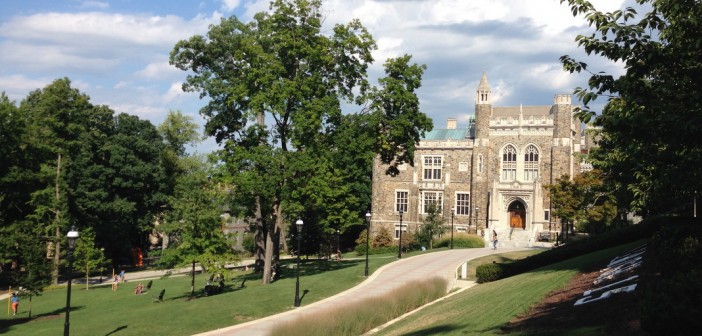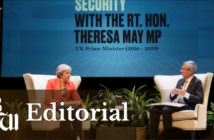As a result of a civil rights investigation that began in January, Lehigh has entered into a voluntary agreement with the United States Department of Education’s Office for Civil Rights.
The voluntary agreement, which was signed by Interim President Kevin Clayton and emailed to the Lehigh community on Sept. 26, has five major areas of requirements that the university must fulfill. These areas and requirements concern conduct procedures, the creation of an anti-discrimination statement and increased reporting to the Department of Education.
University officials are working on addressing and implementing these requirements by the Feb. 27, 2015, deadline set by the Office for Civil Rights.
However, in the wake of last year’s incidents of racism and Lehigh’s long-term problems of diversity and inclusion, administrators, staff and faculty are already addressing many of the stipulations in the resolution.
The OCR investigation and resolution
Many of these initiatives are in response to the Umoja House vandalism and other issues of inclusivity from the past school year and also seek to improve Lehigh’s campus climate. However, other changes that will come in the next few months will be as direct results of the stipulations mandated by the Office of Civil Rights.
The voluntary agreement is the outcome of the January investigation that looked into the possibility of Lehigh’s improper reporting of the Umoja House incident.
Susan Magaziner, ’77, filed the complaint, saying that the university reported the incident as criminal mischief instead of a hate crime.
Provost Patrick Farrell said when investigating the scene, the police are trained to look for certain elements to distinguish between the two, as established in the criminal code.
“There is not much wiggle room; it is based on ‘what does it look like?’ and ‘how do we classify it?’,” Farrell said. “The Lehigh University Police Department was the investigating arm and (is) responsible to Lehigh and the district attorney. It is not like you get to choose any category you want; the way the laws are written are fairly specific to characteristics.
Farrell said the investigation by the Office for Civil Rights mainly consisted of communication with the General Counsel’s office. The Office of Civil Rights sent several rounds of questions based on the complaint that was filed and the various offices or departments supplied the necessary information.
Mandates from the voluntary resolution include an anti-discrimination statement that is required to be posted around campus and published on Lehigh’s website. Additionally, a racial harassment policy with specific elements, including identification of activities considered racial harassment and a requirement that Lehigh personnel report all incidents and other stipulations concerning reporting and policies, were included.
The five major areas outlined in the Voluntary Resolution Agreement include an anti-discrimination statement, a racial harassment policy, a staff and student training on racial harassment and student-focused remedies for racial harassment.
The closing of the investigation offers the university another opportunity for progress, but not all are satisfied with what the agreement signifies. Brenda Martinez, ’15, a core member of FBR, said some students “hoped the case would continue and Lehigh would own up.”
“It is really frustrating to see that every time we think (institutional change) is going to happen, it gets slower or we don’t hear about it anymore,” she said.
Farrell said the administration and appropriate offices, such as the Office for Student Conduct and Community Expectations, the General Counsel and the Office for Academic Diversity, are working on implementing the requirements in the voluntary agreement. However, the requirements listed are not necessarily absent at Lehigh.
“The expectation of the new racial harassment policy is to look at student conduct policy, but we don’t know for a fact that it doesn’t already adequately cover what the Office of Civil Rights said,” Farrell said.
The background
The subjects of diversity and inclusion at Lehigh are not new problems — but ones that, in the course of the past year, have been brought to the surface and become points of discussion for administrators, faculty, staff and students.
In the past calendar year, there have been several very public issues.
A fight outside Leon’s Restaurant and Bar between football players and members of the Phi Kappa Theta fraternity over an alleged use of a derogatory term happened last September.
The public introduction to the From Beneath the Rug movement, complete with the chalking of campus, signs posted in buildings and silent protest happened in October.
The Umoja House vandalism — which included racial slurs and eggs covering the building’s facade — and subsequent campus rally, which drew over 1,000 students and members of the Lehigh community, happened in November.
In the 2014 spring semester, the application Yik Yak exploded in popularity, and anonymous users’ posting of homophobic, racist and misogynistic language drew criticism and anger from members of the Lehigh community.
In April, it was announced that a member of the Sigma Chi fraternity was charged with the Umoja vandalism and subsequently expelled. The fraternity was also charged with several violations of the university’s Code of Conduct, but was only found guilty of “Respect for Self — Unauthorized consumption, distribution, or possession of alcohol.”
Most recently, Phi Kap is being investigated for a drinking song with lyrics that include, “He’s gay, he’s gay, he’s gay, as f—.” The fraternity is facing charges of harassment, hazing, supplying false information to university officials and several alcohol violations.
FBR, a grassroots student group that formed in October of last year, actively responded to the fight outside of Leon’s and overall treatment of marginalized students on campus.
The group publicly criticized the administration and campus climate and brought up several demands that they felt would help change the campus climate and provide necessary resources for marginalized students.
One of these demands was the Summer Scholars Institute where first-year students, including first-generation college students, could become acclimated to Lehigh and be mentored. Other demands included a diversity class requirement be created for all undergraduate students, and that the university be more forthright when addressing diversity issues and not “sweep them under the rug.”
The group has taken a less public role this year, which was intentional.
“The work is not done, but (FBR core members) are taking a backseat,” Martinez said. “Leaders should lead in the back; that is the approach (that we are taking), just watching. Other students come and talk to me, but I say to them, ‘Now you need to speak up, because I can’t speak all of the time.’”
Addressing OCR and moving forward
Different constituencies on Lehigh’s campus have responded in different ways.
Administrators have created new programs and brought in training for faculty, staff, and students. The Board of Trustees has created a Diversity and Inclusion sub-committee that will focus on the issues. Student organizations have emphasized cross programming with other groups in order to support each other and achieve larger initiatives.
Additionally, the staff and student training on racial harassment has been worked on by university officials in the form of VISIONS and CITE, or the Cornell Interactive Theater Ensemble, for board of trustees members, faculty, staff and some students.
VISIONS is a framework that allows those who have gone through the two-day process to use a particular language when discussing inclusion or multicultural issues. This language allows those in the conversation to all be heard and understand what each other means more clearly.
Henry Odi, vice provost for academic diversity, said CITE training was provided for 534 faculty, staff from all levels and six Board of Trustees members in early September.
This training used vignettes and reflection conversations to communicate how issues of sexual orientation, socioeconomic status, age discrimination and race play a role in the workplace.
Odi is planning on hosting this workshop again in November for faculty and staff that did not attend the first time. Also, in early December, there will be a student-focused CITE session. 178 student leaders were identified as important individuals to participate in the training and will be among those invited to attend in December.
Although the administration has made significant efforts to address campus climate issues, students still have concerns about the effectiveness of the time and resources used and whether the programs are truly making a difference.
“I have my issues with a lot of things the administration did,” Martinez said, also mentioning that numerous conversations were had about where university funding should go to address relevant issues.
“Why so much money to the U house? And what are you trying to do? To me, it is though you are trying to cover up, you are trying to make a trophy out of something it shouldn’t be,” she added.
Martinez also suggested the administration use the money to open up available housing on “the Hill” to foster a more diverse community than just Greek students.
One of the entities that has been communicative regarding diversity and inclusive issues is the Council for an Equitable Community. Former Lehigh President Alice P. Gast originally formed the CEC in 2007, but members of the organization said that it was not a very active group until the incidents of last fall.
Chairperson of the CEC and Dean of Athletics Joe Sterrett said that the group is trying to take a more active role in the campus dialogue while also looking long-term on how to improve campus climate. He and other members of the CEC recognize that this is not an easy task.
“Change happens, but the change that you have to push is because it is difficult,” said Jennifer Swann, an executive member of the CEC. “Something has to be given up and power has to shift, and those are the changes that are hard and require some work.”






Comment policy
Comments posted to The Brown and White website are reviewed by a moderator before being approved. Incendiary speech or harassing language, including comments targeted at individuals, may be deemed unacceptable and not published. Spam and other soliciting will also be declined.
The Brown and White also reserves the right to not publish entirely anonymous comments.
1 Comment
Provost Farrell is spot on….There is no “wiggle room” in campus crime and reported mandates. He is very confused about jurisdictional authority however. After classifying the UMOJA incident as “criminal mischief” and refuting allegations of mis classification the LU Crime and Safety Report, with an October 1 mandated reporting shows the crime as “hate” crime of “vandalism/ethnicity”. Seems like those allegations of mis-classification that Lehigh administrators called “without merit” did indeed have merit. Also Pat, OCR does not have jurisdictional authority over campus crime. That’s the work of FSA Clery FBI. Hate crime classification is not and never was a part of the civil rights investigation — it’s not in that department’s jurisdictional authority. The OCR case investigation was opened on grounds of “racial hostility”. You need to be on board dude!